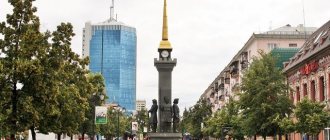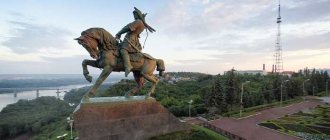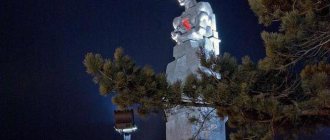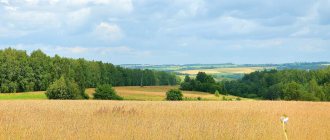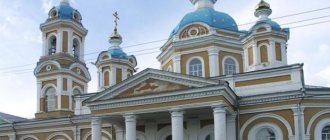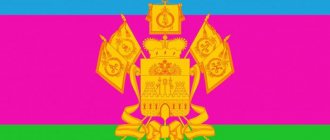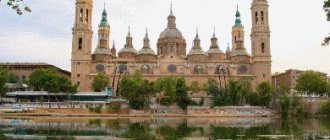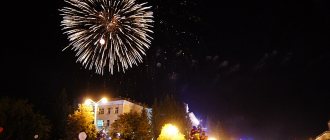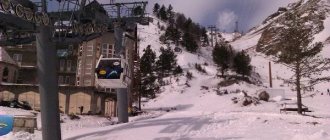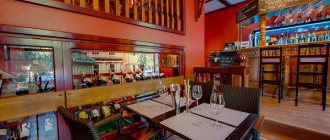Sights of Kirov – where to go and what to see
The history of Kirov, the sights of which are collected in this article, begins in 1374.
At that time, the settlement was called Vyatka, after the name of the river on the banks of which the first houses were built. In the middle of the 15th century the city began to be called Khlynov. At this time, the Novodevichy Transfiguration Monastery was created, and later the Trifonovsky Monastery; these sights of Kirov then played a major role in the development of the city and its history. Now, the city is a large industrial center. The sights and beautiful places of Kirov are visited not only by local residents, but also by tourists. If you decide to visit these places, we have selected the main attractions of Kirov, photos and descriptions, so it will be more convenient for you to navigate, plan your route and see all the beauty of the city not only in photographs. What to see in Kirov:
Assumption Trifonov Monastery
Assumption Trifonov Monastery is a male monastery in Kirov, founded in 1589 by Trifon of Vyatka.
At first there was a wooden temple on this site; in 1589 the Assumption Church was erected; six domes had different heights; according to historians, this was a unique structure of that time. A hundred years later, the structure became stone; everything was built from stone, even the fence that sheltered the monastery from prying eyes.
In the 20th century, most of the time the monastery was abandoned or used for the needs of the authorities. In 1991, the work of the monastery was resumed, and the entire ensemble was given the status of an architectural monument.
Address: Kirov, st. Gorbacheva, 4 Phone: +7 8332 64‑15-87 Opening hours: daily from 07:00 to 19:00
Church of John the Baptist
A monument in Kirov that has great historical value is the Church of John the Baptist. It began to be built in 1714 on the outskirts of the city. The work was completed after 9 years, and at the end of the century the building was rebuilt, in particular the height of the main nave was increased.
During Soviet times, the church housed the Society for the Protection of Monuments, and the building was converted into a planetarium. The temple was returned to the Vyatka diocese in 1994. And at the moment it is the most beautiful landmark of the entire Vyatka region.
Address: Kirov, st. Svobody, 54d Phone: +7 833 265‑03-61 Open: daily, 7:00–19:00
Content
- 1 Project topic
- 2 Creative project name
- 3 Project idea
- 4 Project product
- 5 Authors and participants of the project
- 6 Project problem
- 7 Student Research
- 8 Variety of city monuments.
- 9 Our city bears the name of this man.
- 10 Monument to Vladimir Ilyich Lenin
- 11 Monument to artists, Vasnetsov brothers
- 12 Description of the participant’s activities
- 13 Criteria for evaluating work
theatre square
Theater Square is a popular place in Kirov. There are always a lot of walking students, families with children, and couples in love. The square is considered the real center of the entire cultural life of the city. This is where all the city holidays take place, and local residents nickname the square “theater room”. The building of the Regional Legislative Assembly is located on the square.
The Kirov Drama Theater gave the square its name.
Vyatskaya Vasnetsov is a museum visited by tourists coming to the city.
Address: intersection of Karl Liebknecht, Moskovskaya and Karl Marx streets
Tsiolkovsky Museum
In Russia there are only 4 museums associated with the name of Konstantin Eduardovich Tsiolkovsky and one of them is located in the city of Kirov.
The museum is located in the former mansion of the merchants Shuravins, and in 1873-1878 the family of the founder of astronautics lived here. The museum exhibits will clearly show how Tsiolkovsky lived; his personal belongings, editions of his lifetime works, documents and much more are stored here.
The museum is engaged not only in educational activities, but also in research activities, disseminating Tsiolkovsky’s ideas.
Monument to Vladimir Ilyich Lenin
(1870–1924), (Real name - Ulyanov.) Revolutionary, political figure in Soviet Russia, leader of the Bolshevik revolution, one of the organizers and leaders of the October Revolution of 1917, chairman of the Council of People's Commissars (government) of the RSFSR and the USSR. Philosopher, Marxist, publicist, founder of Leninism, ideologist and creator of the Third (Communist) International, founder of the Soviet state. One of the most famous political figures of the 20th century. The scope of his main scientific works is philosophy and economics, head of the Soviet government (1917–1924).
Sculpture Family
Not long ago, a sculptural composition called Family was installed near the building of the Puppet Theater. The ensemble is made in the traditions of Dymkovo toys, it is a man with an accordion sitting on a bench, a woman with a child in her arms, a little boy standing next to him, a cat and a dog complete the composition. Next to them there is a place where you can take a photo or just sit on a bench.
The monument has become a symbol of family unity, and newlyweds come here to make a wish that will surely come true.
Address: Kirov, st. Drelevskogo, 22
Project idea
People pass by, rushing about business. It’s just that city residents don’t notice things that seem ordinary to them, but in fact are fraught with enormous cultural and historical value. Our city is associated with many great events and interesting people. We want to tell you about the buildings that preserve the memory of these events and people, that is, we want to tell you about the monuments of our city. These include sculptural monuments, busts, pedestals, memorial plaques and steles, of which we have a considerable number. The Department of Culture of the Kirov City Administration is concerned about the attitude of Kirov residents towards the cultural heritage of the city. In particular, skateboarders who “attacked the areas around the monuments, not honoring the memory of the heroes and destroying the integrity of the pedestals.”
We want to tell you more about the interesting monuments of our city. So that people remember the history and heroes of their city.
Alexander Garden
One of the oldest parks in the city, Alexander Garden, was founded in 1825, after Alexander the First visited Kirov.
A good location was chosen for green spaces between the Razderikhinsky ravine and Vyatka; the territory occupied the space between the Pyatnitsky Church and the Transfiguration Monastery.
By 1835, the garden was improved, with nice alleys, gazebos, and a stone bridge. The natural landscape fits well into the overall picture. Today, the Alexander Garden is the best example of park design dating back to the era of classicism.
Address: Kirov, Alexandrovsky Garden
Park named after Kirov
Kirov Park is located in the city center. The development of the territory began in the 70s of the last century; deciduous and coniferous trees, ponds, and lawns appeared. The appearance of amusement parks has made this place one of the leisure centers where families come to have a good time.
Now there are all conditions for recreation - equipped playgrounds, including children's, a beautiful fountain, anyone can rent a boat.
Any citizen or tourist here, on the Alley of Happiness, can order the insertion of tiles with their own name or inscription.
Address: Kirov, Oktyabrsky Ave., 147
The best theaters in Kirov
The most popular theaters and concert venues in the city.
Kirov Drama Theater
Located on the main Theater Square of the city. The stone building was built at the beginning of the 20th century. Its reconstruction took place in the 1950s and 1980s. The theater's repertoire is varied; most of its performances are based on the works of classic playwrights. Among them are works by contemporary authors. The drama theater's performances often become laureates of various awards; the actors have the knowledge of folk artists.
Kirov Puppet Theater
Located in the historical center of the city on Spasskaya Street. Its history begins in 1935. Puppet theater productions are interesting for both young and adult spectators. About 30 performances are shown on an ongoing basis, and bright musical shows are held. The modern theater building was built recently and has excellent sound and lighting equipment. The unusual building is decorated with a fairy-tale tower.
Vyatka Philharmonic
Worked in 1958 with the help of a concert and variety bureau. Since 1963, it has been located in its own building on Lenin Street. This gave impetus to the emergence of new groups. Now the Philharmonic has a symphony orchestra and an orchestra of folk instruments, a string quartet and a concert ensemble. Famous artists - Zykina, Magomaev, Antonov, Leshchenko, Vaikule - perform on tour on the stage of the Philharmonic.
"Theater on Spasskaya"
It is located on Spasskaya Street, which gave the theater its name. It has been working since 1936 in the building of the merchant Arshaulov. The theater's productions are designed for different categories of spectators - children and adults. Productions by Russian and foreign playwrights are popular. Adult contemporary experimental productions are especially original. The theater's list of awards includes awards from prestigious festivals, including the Golden Mask.
Wish tree
In the park, not far from the Drama Theater. Kirov has a unique composition, the Tree of Wishes. Laying the foundation for the tree lasted a week. Letters with the wishes of the townspeople were placed in a box under the tree, that is, thanks to this, it grows, of course, only symbolically.
The opening of the art object was a celebration. At the ceremony, those present shouted “I allow” in unison, which became a sign that the tree would grow and fulfill everyone’s wishes to the joy of everyone. An ear is carved on a tree; everyone can come here and whisper their deepest desire. It is interesting that the concrete tree looks like a real one, it is so skillfully made by craftsmen.
Top 20 most interesting art objects in Kirov
Today we will talk about the most interesting and memorable art objects of our city. Starting with those that were built quite a long time ago and have already become a favorite among Kirov residents, and ending with those that were opened quite recently.
"Tree of Wishes" . On May 5, 2007, a monument was erected that “listens” to the wishes of Kirov residents. It represents an oak tree with an ear, and was staged by a local radio station. Before the installation of the monument, an action was held in which notes with the cherished desires of the townspeople were collected. Then the collected wishes were buried at the base of the “Wish Tree”. The monument stands in the park near the Drama Theater on Theater Square.
"Family" . Near the Puppet Theater, on Spasskaya Street, 22, there is a sculptural composition “Family”, made in the style of a Dymkovo toy. Legends immediately arose around the sculpture that it fulfills wishes. The sculpture says: “If you dream of a strong family, sit on a bench; if you want a cheerful, carefree life, touch the accordion; if you want to prolong your family line, touch the baby.”
"Running on the waves" . The sculpture was unveiled on June 4, 2013. It is dedicated to the heroine of the novel Frezi Grant by writer A. S. Green. As the author of the sculpture said, he tried to put lightness, femininity, hope and faith in the fulfillment of a dream into the image of the heroine. The sculpture is located on the territory of the pond near the Kirov Circus.
"Assol" . The sculpture was opened on August 25, 2013 on the Days of Romance in the Kirov Park. It is dedicated to the main character of A. S. Green’s story “Scarlet Sails” - Assol. It symbolizes unshakable faith in a dream that has come true in real life.
"Royal" . In honor of the 640th anniversary of the city of Kirov, on June 1, 2014, a sculpture “Royal” was opened in the Musical Square at the intersection of Spasskaya and Derendyaeva streets. According to the author's idea, before the official presentation of the sculpture, it was located in the open air, because the piano should be rusty. The sculpture became a kind of gift from friends from the city of Kirov to People’s Artist of the Russian Federation Dmitry Malikov.
Top attractions (727)
Kazan City Hall is located in the central part of the city, on Freedom Square. Nearby is the building of the Concert Hall. S. Saidashev and the Opera and Ballet Theater named after. M. Jalil. The town hall building was built in 1854.
Two 46-meter-high steles in the shape of a half-opened book were installed on the shore of Izhevsky Pond in 1972. A group of sculptors and architects led by A.N. Burganov and R. worked on the creation of the monument.
The light green building in the Art Nouveau style on the historical street of Syzran was built in 1908 for the member of the Syzran district Zemsky Assembly, Pyotr Vasilyevich Revyakin. P.V. Revyakin was also the founder of the first pawnshop in the city and one of the three directors of the Relyevsky Mills Partnership.
The symbol of the city of Engels is the salt bull. And although the monument was erected relatively recently (June 12, 2003), the history of the symbol goes far into the past. Salt was once worth its weight in gold. It was usually mined from salt lakes.
The building of the Saratov State Conservatory was built in 1902 by St. Petersburg architect A.Yu. Yang for a music school. In 1912, under the leadership of architect S.A. The Kallistratova building was reconstructed and added elements of South German Gothic.
In the central district of Naberezhnye Chelny there is an Art Gallery, founded in 1980 as a branch of the State Museum of Fine Arts of Tatarstan. As a state repository of art treasures, the gallery carries out cultural, educational and scientific research activities.
On the day of national unity and the ninetieth anniversary of the statehood of Udmurtia - November 4, 2010, an unusual monument was inaugurated on the central square of Izhevsk. The author of the idea is Nikolai Khaliullin and the sculptor P.
The most touching monument in Togliatti, which has become an urban legend, is located on the Southern Highway in the Avtozavodsky district. On a granite pedestal stands a one and a half meter bronze sculpture of a German shepherd, whose boundless devotion still touches the hearts of millions of motorists.
The Kul Sharif Mosque is the main mosque of Tatarstan and Kazan. The construction of the mosque was completed in 2005 and dedicated to the thousandth anniversary of Kazan. The mosque is located in the western part of the Kazan Kremlin.
One of the main regional monuments dedicated to labor and military exploits in the Great Patriotic War in the city of Penza is the Victory Monument. The memorial, installed on May 9, 1975 in a new microdistrict, which later became the central district of the city, has a height of 5.6 meters and is now part of the architectural composition of Victory Square.
On the approach to the Yelabuga settlement in 2007, a monument was erected to the founder of the city - the Bulgarian emir Ibrahim I ben Muhammad. The authors of the bronze monument, weighing fifteen tons, were: Kazan sculptor Makhmud Gasimov, artist Firinat Khalikov and architect Marat Maskudov.
In November 1967, a monument was unveiled in the capital of Bashkiria, Ufa, which for almost half a century remains the largest equestrian statue in all of Russia. The grandiose sculpture, weighing forty tons and almost ten meters high, was installed at the highest point of the city, on a steep cliff rising above the Belaya River.
100 km from Penza there is a most picturesque place - the Tarkhany Museum-Reserve, where the brilliant Russian poet Mikhail Yuryevich Lermontov grew up. A unique historical and cultural monument was opened in the village of Lermontovo (formerly the village.
On April 12, 1961, near the city of Engels, Saratov region, residents of the village of Smelovka heard an explosion in the sky and saw two parachutes descending to the ground. The villagers then had no idea that they were witnessing a historical event on a global scale.
The monument to Musa Jalil, the Tatar poet and patriot, is located at the main entrance to the Kazan Kremlin, not far from the Spasskaya Tower. The sculpture was installed in 1966. The authors of the monument were sculptor V.E.
On June 23, 2011, in the center of the capital of the Republic of Mari El, a sculptural composition of a folklore character, Yoshka the Cat, was installed. The bronze sculpture weighing 150 kg, cast in Kazan, is the result of the work of two Yoshkar-Ola sculptors Anatoly Shirnin and Sergei Yandubaev and Muscovite Alexei Shilov.
Opera and Ballet Theater named after. Musa Jalil is located on Freedom Square in the center of Kazan. Construction of the theater building began in 1936. The author of the project was Moscow architect N.P. Skvortsov. In 1948, the building's facades and interiors were redone under the direction of Kazan architect I.
The State Nature Reserve of Bashkiria with an area of 22,531 hectares, located in the Burzyansky district, was created in 1958. The name Shulgan-Tash is translated from Bashkir as “a river that has fallen into stone.”
A beautiful mansion with an openwork fence and griffins at the front entrance adorns the historical part of the city of Kirov. The building in a mixed Gothic style with oriental exotic motifs belonged to the owner of the Vyatka-Kama Shipping Company, philanthropist and eminent merchant Tikhon Filippovich Bulychev.
The Tatar State Puppet Theater "Ekiyat" was created in 1934. It is considered one of the oldest children's theaters in the country. Over the entire history of the theater, about three hundred performances were staged. Now the theater's repertoire includes more than forty performances: productions of fairy tales from peoples of the world, historical performances and productions with modern themes.
Variety of city monuments.
It should be noted that all cultural heritage sites are divided into several types: historical monuments (various buildings - Bekhterev's house or Green's house-museum); archaeological monuments (remains of the earthen rampart of the city of Khlynov); architectural monuments (the ensemble of the Trifonov Monastery, etc.) A special subtype of historical monuments includes steles, pedestals, obelisks, memorial areas and plaques that immortalized the heroic efforts and sacrifices of soldiers at the fronts and home front workers during the Great Patriotic War. All these objects may have the category of federal, regional or local historical and cultural significance.
Architectural monuments and museums of Kirov
We will not sin against the truth if we say that Kirov is one of the most beautiful cities in Russia. Many businessmen and tourists come here every year. The former come here for business purposes, the latter to see the sights of Kirov. And this year there is one more reason to visit the ancient city - the first ever Fairytale Games started, which attracted hundreds of tourists from all over our vast country. And, of course, many of them rented apartments for daily rent in Kirov, due to the fact that hotels simply could not cope with such an influx of tourists. But that’s not about that now.
Now we want to tell you about the architectural monuments and museums of the city . Let's start with the monuments, most of which are located in its central part, which is located on the high bank of the Vyatka River. These monuments are silent witnesses to the affairs of bygone days and an excellent illustration of the rich history of the Khlynovskaya fortress (the original name of the city of Khlynov - read more about this in this article).
The first architectural monument we will visit is located on the slope of the Zasorsk ravine, south of the fortress. More precisely, it is a whole complex of monuments. Its name is the Holy Dormition Trifonov Monastery (Gorbachev St., 4). The monastery is active, revived in 1991. Its main attraction is the magnificent five-domed Assumption Cathedral , built in 1864-1889. The interior of the cathedral is distinguished by a five-tiered iconostasis with ancient icons, which was restored in the 20th century and covered with wonderful Palekh painting. Also prominent in the ensemble of the monastery are: the gate St. Nicholas Church, opened in 1690-1695, the Annunciation and the Three Saints churches, and cells. Pilgrims can easily rent rooms for daily rent in Kirov in the vicinity of the monastery, which, you see, is nice.
In general, everything is fine with the monasteries in a city with a clearly communist name; this is apparently a kind of mockery of fate. Another famous religious building of the city is the ensemble of the Spaso-Preobrazhensky Novodevichy Convent , founded in 1624, with the incredibly elegant and festive Spaso-Preobrazhenskaya Church . True, his address is somewhat mysterious: Dinamovsky Proezd, no. 6. But I think you won’t get lost in any case. Architectural monuments of the 17th century are located here. The monastery was restored in 2001 and is currently active.
The Church of St. John the Baptist (54-d Svoboda St.) from the 18th century is very unique For many townspeople, it is not even associated with the church. There was a planetarium here until the 60s. And only in 1994 the building was transferred to the jurisdiction of the diocese. Then his long recovery began, almost piece by piece.
The stone Trinity Church (Proezzhaya St., 27) was built in 1770-1775 by Khlynovsky architects Vasily Shvetsov and Pyotr Rupasov. This magnificent example of a tiered temple has survived to this day practically without reconstruction, especially significant ones. Which is very rare. The building has recently become located within the city, so keep in mind that in this area you can still rent a picturesque house for daily rent and enjoy provincial peace and tranquility.
After visiting religious buildings, you can go to see the monuments of civil architecture. Such as: the building of the former official hut (Drelevskogo St., 4 b), the buildings of provincial government offices (Dinamovsky Proezd, 2, 4), made in the style of classicism. Among the civil architectural monuments, the complex of park buildings located in the Alexander Garden (read more about this in the Green Kirov route) especially stands out. However, it would take a long time to list what you will see on site; we advise you to simply walk through the center of Kirov and see everything for yourself. Unfortunately, in all these eclectic mansions with intricate carvings, stone giants from the Classical era, apartments are not available for daily rent in Kirov, but you can find more comfortable housing, even if not in a historical building.
As for museums, they are often associated with the names of artists, writers, and architects who were in one way or another connected with the city of Kirov. The Vyatka Folk Art Crafts Museum is especially popular among tourists . This is understandable. After all, Vyatka is the birthplace of the famous Dymkovo toy. The museum is located in the above-mentioned architectural monument - Prikaznaya Izba (Drelevsky St., 4b). However, the museum exhibits are very diverse: lace, clay products, embroidery and weaving samples.
Another interesting museum is the Art Museum named after V.M. and A.M. Vasnetsov (Karl Marx St., 70). It opened in 1910. This is one of the oldest art museums in our country. It is located in a beautiful building of the 19th century. The exhibition included quite interesting collections of Western European and Russian paintings, as well as ancient icons.
There are also literary museums in Kirov. One of them is the House-Museum of A.S. Green (Volodarsky St., 44). The only one in Russia, by the way. It was built in the place where the writer spent his childhood and youth.
Another literary museum is closely connected with the name of the famous Russian satirist M.E. Saltykov-Shchedrin ( House-Museum of M.E. Saltykov-Shchedrin - Lenin St., 93), who was exiled into political exile in Vyatka and lived here for seven years. The writer rented rooms for daily rent from I.H. Rush, a foreman at the Medyansk paper mill. And in 1968, a museum was opened in this house on a voluntary basis.
Museum of K.E. Tsiolkovsky , aviation and astronautics in Kirov (Engelsa St., 16) is one of four museums associated with the name of this great scientist in Russia. It opened its doors to visitors in 1988. It is located in a historical building that once belonged to the merchants Shuravin. Doesn’t really fit in with space, does it? The fact is that the Tsiolkovsky family once lived here. Yeah, apparently they rented apartments for daily rent in Kirov, no less.
Well, for dessert we advise you to go to the Vyatka Kunstkamera (Moskovskaya St., 12-a). In five halls of which there are... no, not preserved corpses of babies. Here there are exhibits in one way or another related to urban life of the 19th century: collections of watches, porcelain, earthenware, furniture and various artistic products. As you can see, the city can surprise. And it’s nice to be surprised. After all, Kirov is one of the oldest cities in Russia!
With this, we say goodbye to you and wish you a pleasant journey and a sea of bright impressions. October 27, 2016 Tags: Routes , Interesting places , Museums , Temples
Where to go with children?
You can have an unusual and interesting time with your children at the Chocolate Museum and the Museum of the History of Ice Cream.
Museum of the History of Chocolate "Criollo"
Located in the historical center on the main street of the city – Spasskaya. The museum's exhibitions tell about the history of chocolate production in Kirov, its development and stages of production. Several themed rooms have been decorated. Visitors can take part in a chocolate making master class. In the chocolate boutique you can buy unusual confectionery sweets and handmade sweets.
Museum of the History of Ice Cream "Artico"
Another interesting museum on Spasskaya Street, telling about sweets. The unique museum is stylized as a snowy yurt. The white walls of the halls are decorated with artificial luminous pieces of ice. Many museum exhibits exist in a single copy. The guides tell the story of the origin of ice cream and show machines from production. In the tasting room you can try desserts and take part in master classes.
Kirov State Circus
A striking landmark of the city, located on Oktyabrsky Avenue. The circus building was built by analogy with Moscow projects. The modern entertainment center is equipped with excellent sound and lighting equipment, allowing for high-level shows, including performances on ice and water. The circus has a stable and enclosures for animals, and has its own hotel. The circus seats 1600 spectators.
Yurkin Park
An amusement park with moving dinosaurs is located on Talitskaya Street. His entertainment will be of interest to both children and adults. Huge dinosaurs are made with great naturalism. Information stands are installed next to the figures of prehistoric animals. Children will appreciate the archaeological site where excavations can be carried out. In summer, the park has a swimming pool, a beach, and a cafe.
Five monuments of the Vyatka Baroque in the Kirov region that can be seen over the weekend
The weather is not kind this summer, but staying at home is a bad idea, we decided and went to see the Vyatka architecture of the 17th - 18th centuries. Or rather, the temples and cathedrals that have been preserved in the vicinity of Kirov. Let’s say right away that you can look at them for hours, and you can trace from them how the architectural style has changed on Vyatka land.
By the way, the first brick buildings in Khlynov appeared only at the end of the 17th century. Due to the high cost of brick, this material was used mainly for the construction of religious buildings, and temples were founded on voluntary donations from local residents and patrons of the arts. At that time, the Moscow Baroque architectural style was gaining popularity in Central Russia, the distinctive feature of which was the upward movement of buildings, their multi-tiered and patterned facades. It replaced another popular style - patterning, which was characterized by intricate shapes, complexity of composition and abundance of decor.
Spaso-Preobrazhenskaya Church (Kirov, Dinamovsky proezd, 6)
Our trip begins with this temple. The Transfiguration Church is one of the surviving creations of the famous artel of local craftsman Ivan Nikonov, whose craftsmen had a hand in creating many stone buildings in Khlynov in the early 18th century. The church was built in 1696. At that time, buildings were decorated with intricate brick carvings with folk art and scope in the spirit of Russian pattern design. With the originality already inherent in Vyatka masters. As you can see, window casings add elegance to the façade.
To get closer to the Church of the Transfiguration, you need to show patience and perseverance. The fact is that the temple is surrounded by a fence, behind which you can go “only with the blessing of your mother.” We, of course, managed to get through the fence - it was open due to construction work, but when they saw us, they sent us for a blessing.
Temple of the Trinity Church (Kirovo-Chepetsky district, Kstinino village, Sovetskaya str., 61)
Half an hour's drive from Kirov in the Kirovo-Chepetsky district is the village of Kstinino. Driving through it, it is impossible to miss the bell tower of the Trinity Church in the classicism style of the 19th century. It attracts the eye with its scale. However, behind it lies another architectural monument - a temple built at the turn of the 17th - 18th centuries.
Before us is a façade decorated with brick carvings and platbands, and each one is different in some way. Unfortunately, it is clear to the naked eye that this majestic temple needs restoration.
Cathedral of St. Nicholas the Wonderworker (Nolinsk, Lenin St., 33a)
The journey from Kstinino to Nolinsk takes almost two hours, but what we saw was worth the long journey. Firstly, on the way to the city you can stop in the village of Kyrchany, where there is a bell tower of the Life-Giving Trinity, built in the second half of the 18th century, also in the Vyatka Baroque style. And secondly, in Nolinsk there is the Cathedral of St. Nicholas the Wonderworker of the first quarter of the 18th century. It was formerly surrounded by a large wall, the remains of which can still be found near the temple.
The platbands on the windows catch your eye. The curls on them rise upward, turning into a new row of curls. Between the first and second rows there is space left for other patterns, and the window kokoshniks have an additional decoration - there are rosettes inside them. Moreover, such a riot of imagination does not burden the decor of the cathedral, but creates a special appearance.
In Nolinsk we stopped briefly to rest and have a snack at the “Culinary” on the street. Communes, 7, there are very tasty and cheap baked goods. By the way, a spoiler: the next “Own Route” will be dedicated specifically to Nolinsk. We will tell you in detail what is remarkable about this city and what you can see here.
Church of the Sign and Mother of God (Kirovo-Chepetsky district, Pasegovo village, Podgornaya st., 14)
From Nolinsk we headed to the village of Pasegovo to see the Church of the Mother of God of the Sign, built in the first half of the 18th century. The distance between settlements is more than 220 kilometers and more than two hours’ drive.
This church is one of the pearls of Vyatka architecture. It was built in the first half of the 18th century. Now it is being restored, and the restored facades frankly delight the eye with their pomp.
We were again lucky to have good people and were able to communicate with restorers. They say that when recreating the patterns, they had to comprehend the intricacies of brick carving, and some of the patterns were recreated from flask stone - it is much more convenient to work with.
Before heading to the next settlement, we filled up the tank at the Dvizheniye gas station near the village of Strizhi. There we also picked up aromatic coffee and pastries for the road. By the way, now all Dvizhenie gas stations in the Kirov region sell a lot of useful products for outdoor recreation, which is very convenient.
Catherine's Cathedral (Slobodskoy, Volodarsky St., 54)
Another interesting monument of the Vyatka Baroque is the Catherine Cathedral in Slobodskoye. The building was built at the turn of the 17th – 18th centuries, and in it, as in the Church of the Transfiguration, one can see the architectural style of the artel of Ivan Nikonov. If you have time, you can devote a separate day to it, at the same time exploring other sights of Slobodskoye.
In 1914, the cathedral was rebuilt according to the design of the architect Ivan Charushin, two chapels were added - from the south and north. The decorations of the ancient part of the church have been preserved.
This is such an unusual trip this time. We returned late in the evening, tired but happy. We wish the same for you, because traveling to your native land is cool.
Where to refuel on the way to the cultural monuments of the Vyatka Baroque, see on the map:
Springs and holy springs of the region
The Kirov region is one of the most “holy” regions of Russia. Before the revolution, it was called “The Land of a Thousand Churches.” This explains the large number of holy sources and springs that have miraculous powers.
Nizhneivkinsky mineral springs
- Coordinates: 58.199611, 49.523056.
They were known back in the 15th century. Peasants from nearby villages considered their water healing. In the 19th century, a monastery was built next to the springs and the monks began to use them for medicinal purposes. In the 20th century, a hospital was built here, which today has turned into a real resort area.
Mineral water and hydrogen sulfide mud are used for health procedures, and a good microclimate contributes to effective treatment. Each source has its own unique composition and is used for different diseases. Today, Nizhneivkinsky mineral springs are included in the list of national heritage of Russia.
Spring under Sokolya Mountain
- Coordinates: 58.161564, 48.347921.
Sokolya Mountain in the Kotelnichsky district is an amazing and mysterious place in itself. At its top there was once an ancient temple where people made sacrifices and prayed to their gods. And at the foot of the mountain there is a unique relict spring.
According to scientists, its age is tens of millions of years. The spring is fed by a gradually melting ancient glacier. The water in it is pure, without any impurities. Local residents consider it alive and claim that it energizes everyone who washes in the stream.
Holy springs Ajim
- Coordinates: 56.740278, 50.276667.
S. Adzhim, Malmyzh district - is considered a holy place. Pilgrims constantly flock to it. It's all about the springs that surround the village on all sides.
The Holy Spring is on the south side, Isaevsky spring is in the east, Kuchansky spring is in the north. The Western Spring is located between Ajim and one of the nearby villages. The water in them has no taste, no color, no smell.
Not a single spring has anything to do with faith; they are revered equally by people of different nationalities. Although, according to legend, an icon of the Bishop of Amafunt, Tikhon, was found from one of them.
Kugersky spring
- Coordinates: 57.101465, 49.858545.
The spring near the village of Kuger in the Urzhum region is called the Holy Key. And despite the fact that there are many springs in the vicinity, only this one is considered holy. After all, it was in it that Father Tikhon found the icon of the Mother of God.
He himself used the water from the spring to heal ailments and recommended it to his parishioners. Since then, the spring has become a place of pilgrimage and acquired another name - Tikhonov Spring.
